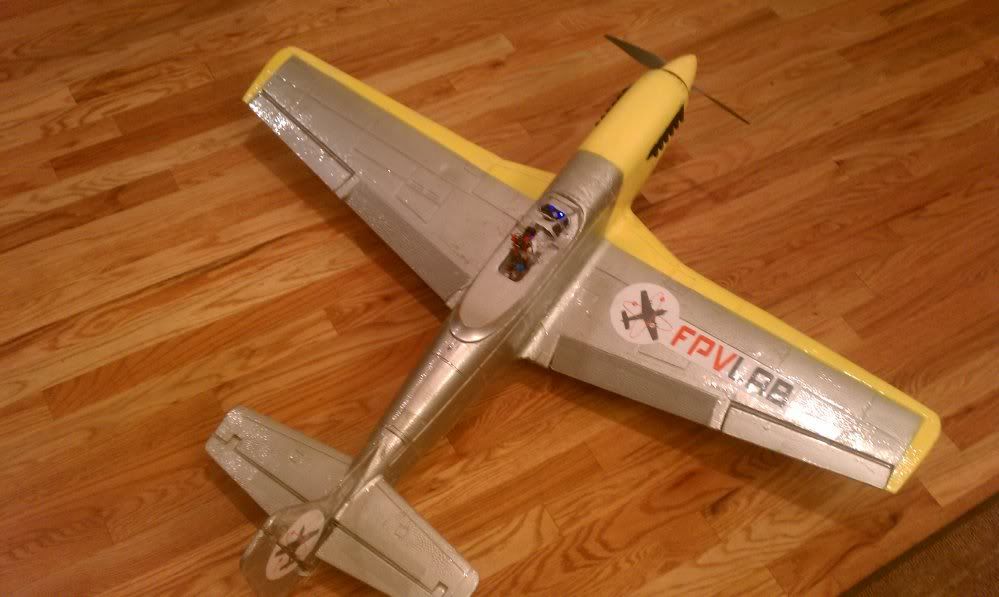|
Ah, I assumed you were going to drill it out with a bigger diameter than the motor shaft but I didn't realize how big the hole might be with respect to the strut's width. I guess it might be hard to compare, since you've changed both your frame from 650mm to 450mm and used a different flight controller, but how does flying with 1000kV motors feel compared to your old ~850kV motors? I've been rolling mostly with low kV (~700) since I'm looking for stability but I'd like to get thoughts on how it might be going to a higher kV if I ever bother making a sport quad. Also, for what it's worth, I'm using the KK board and my DT700 motors spool up at around 25% throttle, and hovers at around 60%. Did your old quad spool up with less throttle with multiwii?
|
|
|
|

|
| # ? May 17, 2024 01:44 |
|
Slanderer posted:Anyway, I flew it today with 1000kV motors and 10x4.5" props. Pretty powerful, although the ESC's don't actually move the motors until like 25% throttle, or so. I set the range multiple times via the kk multicontroller, but whatever. I hovers @ 50% with a 2200mAh battery, which is higher than I thought. Maybe the throttle range is just off, because I expected it to hover at ~30%. Did you calibrate the ESC's throttle ranges?
|
|
|
|
yergacheffe posted:I guess it might be hard to compare, since you've changed both your frame from 650mm to 450mm and used a different flight controller, but how does flying with 1000kV motors feel compared to your old ~850kV motors? I've been rolling mostly with low kV (~700) since I'm looking for stability but I'd like to get thoughts on how it might be going to a higher kV if I ever bother making a sport quad. yergacheffe posted:Also, for what it's worth, I'm using the KK board and my DT700 motors spool up at around 25% throttle, and hovers at around 60%. Did your old quad spool up with less throttle with multiwii? Come to think of it, I have no idea (for the record, my main copter uses an ardupilot atm, although I have a cheap multiwii board that I've yet to try). I'll have to fix up the wiring later this week so I can test that. I only got started wondering since the metric I had been looking at in that calc tool was the %throttle for hover.
|
|
|
|
CrazyLittle posted:Did you calibrate the ESC's throttle ranges? I did, via the kk multicontroller. One random post on rcgroups said that you should calibrate the ranges before connecting to the board, and then a second time, but that didn't make sense to me. I've also yet to find any reference to what the ESC timing actually changes, which is such loving bullshit. I can write the firmware for a brushless motor controller, I understand all the practical concerns, yet no one seems to have any concrete knowledge of what this setting does---everyone seems to describe it using the same bullshit pretense of knowledge that people use when describing wine. "Oh, well, it makes the response harder!" THE gently caress DOES THAT MEAN!? Does it affect the mapping between the input and the output drive PWM? Does it change the dead time? Does it affect a software low-pass filter on the input signal width, causing the ESC to response more quickly to changes? Ok, I'm done yelling about this.
|
|
|
|
ESC timing is used to control the torque angle. The ESC uses the back emf to measure speed and uses the timing setting to decide how advanced to run. If you don't have your timing set correctly, then at high acceleration your motors will lose sync, give this hillarious death cry, and your craft will plummet to the ground.
|
|
|
|
A couple of different things: 1) some (a lot) of ESCs have the ability to calibrate the throttle response curve. What this does is it tells the ESC what your signal source's max throttle point and min throttle points are so that it can give you a smooth curve from top to bottom. If you're using only a Tx/Rx for something like a single motor plane, then calibrating tells the ESC that your radio's min/max outputs are where it will calibrate to. 2) flight controller boards don't use the same input curve that your radio sends from the receiver, and instead interprets the receiver's signal and then mixes it for the multi-rotor motor outputs. So now you have the interpreted throttle curve that the board gets from the receiver, and then you also have the throttle output curve to each motor in your flight controller's mixing algorithms that gets sent to each ESC. With multirotor platforms you typically have to trim the radio's output to meet the controller board's expectation of what the throttle curve should be. Single motor: Tx ~~~ 2.4ghz ~~~> Rx --PWM--> ESC KK Board: Tx ~~~ 2.4ghz ~~~> Rx --PWM(1)--> KK Board --PWM(2)--> ESC (1) Input throttle curve to the KK board (2) Output throttle curve to the ESCs 3) ESC timing is a setting to help the ESC compensate for different motor windings for optimal pole-switching timings for different Kv ranges. As lastmanstanding said, the ESC uses back emf across the three poles to measure the motor's spin. CrazyLittle fucked around with this message at 08:29 on May 29, 2012 |
|
|
|
TheLastManStanding posted:ESC timing is used to control the torque angle. The ESC uses the back emf to measure speed and uses the timing setting to decide how advanced to run. If you don't have your timing set correctly, then at high acceleration your motors will lose sync, give this hillarious death cry, and your craft will plummet to the ground. Hah, this finally helped, albeit in a very roundabout way--"torque angle" gave me something to search for to find the relevant info. As far as I can tell, changing the "timing" will change the sense voltage at which the controller switches to the next drive phase, which has the effect of altering the angle between the fields of the permanent magnets in the rotor and the fields produced by the stator when the drive phase is switched. So, thanks...sorta! CrazyLittle posted:3) ESC timing is a setting to help the ESC compensate for different motor windings for optimal pole-switching timings for different Kv ranges. As lastmanstanding said, the ESC uses back emf across the three poles to measure the motor's spin. No offense, but this is exactly the type of banal response I was ranting about, since it doesn't actually tell me anything meaningful.
|
|
|
|
Slanderer posted:No offense, but this is exactly the type of banal response I was ranting about, since it doesn't actually tell me anything meaningful. Okay.
|
|
|
|
CrazyLittle posted:Okay. Upon rereading, it looks like I came across a bit dickish. It's just been kinda frustrating when I've been looking to figure out what that meant, from a practical engineering perspective, and all the responses I read were basically "the timing affects timing it's magic!". So, my bad.
|
|
|
|
Keep in mind that the code for cheap ESCs is a copy of a copy of a copy of Hobbywing's firmware, so yeah, it kinda is magic 
|
|
|
|
Slanderer posted:the angle between the fields of the permanent magnets in the rotor and the fields produced by the stator when the drive phase is switched. That angle is the torque angle and is what allows you to actually make power (Since P=Tw). In this case the controller has no real information about the plant and without knowing the number of poles it can't know the actual torque angle or angular velocity, so instead they went with 'timing'. They could have called it 'phase shift' or something that would have been a little more descriptive as it is generally expressed as a phase difference, but since they are using the back emf for timing, it does make some sense. Out of curiosity, what do you hope to gain by writing your own firmware?
|
|
|
|
TheLastManStanding posted:That angle is the torque angle and is what allows you to actually make power (Since P=Tw). In this case the controller has no real information about the plant and without knowing the number of poles it can't know the actual torque angle or angular velocity, so instead they went with 'timing'. They could have called it 'phase shift' or something that would have been a little more descriptive as it is generally expressed as a phase difference, but since they are using the back emf for timing, it does make some sense. I was looking at the datasheet for an old BLDC controller yesterday, and it used the term "lead angle" (as the controller could be set for 0deg, 15deg, or 22deg, I think). Another place mentioned "lead angle" or "lag angle". Presumably, all of this is referring to the same thing. It's just that the word "timing" throws me off, since I'm thinking of this in terms of electrical angles and whatnot, whereas I'd only say "timing" to refer to some angular value when operating at a fixed RPM or something. TheLastManStanding posted:Out of curiosity, what do you hope to gain by writing your own firmware? As far as my progress: the main existing custom firmware for generic Atmega-containing ESCs (although, some brands are switching for a different microcontroller, it seems) turns out to be written in assembly. I was hoping it would be written in C with assembly routines sprinkled in for time-critical sections, but it looks like the author went all-out with this. It'd be hard to port it to the platform I want to use, so I'll have to start from scratch. However, that's not a huge deal---the microcontroller line I have my eye on has a lot more timer/counters than an Atmega8, and each is a lot more powerful. What this means is that instead of having to rely on caaaareful assembly programming to ensuring correct timing of software-generated PWM signals, I can make full use of the peripherals to take care of that. It does require some finesse in order to prevent shoot-through on the FETs (ie, I can't directly use a HW-generated PWM pair to drive a pair of FETs, I need to add the dead-time into an ISR). Really, generating the dead time properly for each of the 12 half-bridges is the hardest part. After that, I need to fully rewrite my code for BLDC motor startup (which will require actual research!). But, that's a pretty "solved" problem, so I just need to find a good algorithm and implement it. Once I got those nailed down, everything else is pretty simple, and I'll have a lot of CPU time left over for whatever the hell else I want--maybe even full-out balls-to-the-face vector control! It'll probably be programmable via USB (I'd normally use a ttl serial interface instead, but the microcontroller has a USB peripheral, so this is simpler), and probably via I2C (just so an ardupilot or something can talk to it). I'd add a digital interface for setting motor speeds, but I actually have no idea what kind of interface they use (presumably a 2-wire I2C-type interface). Adding a configurable slew rate on the motor speed would be fairly trivial. Hell, if I throw a piezo buzzer on there, I can add in the functionality of a low-battery alarm, too. Putting on a power meter / coulomb counter wouldn't be bad, either, if I still have a couple of ADC inputs left (the controller I have in mind has 16 12-bit 2MSPS adc inputs, so I should be good)--hell, I can setup the ADC to autosample the voltages automatically and buffer them via DMA, so that my main program only needs to throw the values through a digital filter when it has the spare cycles. To non-embedded folks, this means I may be able to have a reasonably-accurate coulomb counter (if I can't measure voltage + current quickly enough, I'd have to implement a messy analog multiplier + integrator, or else I'd miss out on large-current spikes), allowing a reasonable gas gauge to be implemented. It's definitely not gonna be cheaper than 4 chinese ESCs taped together, but it'll be an interesting diversion for me (unless I get bored half-way through).
|
|
|
|
How micro is micro? My craft has a 1ft radius; I'm using 25A ESCs and they are 25% of the total weight (not including battery). I could cut total weight by 16% by switching to a properly sized 10A ESC. When you go small, every gram counts and flying a micro that would actually take 25A would be uncontrollable.
|
|
|
|
TheLastManStanding posted:How micro is micro? My craft has a 1ft radius; I'm using 25A ESCs and they are 25% of the total weight (not including battery). I could cut total weight by 16% by switching to a properly sized 10A ESC. When you go small, every gram counts and flying a micro that would actually take 25A would be uncontrollable. So, I'm just focusing on the power stuff at the moment, since that's the easiest place to start making progress. As for the weight of different ESCs: You can basically use the same exact design for a 2A ESC as a 40A ESC, and there are only a handful of things you need to change: 1. Bigger FETs that can handle more power, which may be in larger packages, with metal tabs. Also, it seems certain ESCs actually end up using multiple FETs in parallel, because it's cheaper than springing for the higher-power FETs in the first place (not always true, obviously). 2. A bigger PCB to fit the bigger FETS (and dissipate their heat),which may or may not have thicker copper. 3. Larger electrolytic capacitors for buffering the input voltage from the battery (they usually stick out of the heatshrink on bigger ESCs). 4. Depending on the configuration of the FETs (n-channel + n-channel OR n-channel + p-channel), as well as their characteristics, their might be more drive circuitry required for higher power. In terms of board layout, and choosing the other components, it's a lot easier to start with higher power in mind, and scale back. The core of the design (both in terms of the microprocessor, and also in terms of what would be located at the center of the PCB) would remain exactly the same, but since the FETs would be lined up along the edges of the board, switching them out for lower power ones in smaller packages would let me decrease the area of the board reserved for FETs, without affecting component layout for everything else.
|
|
|
|
TheLastManStanding posted:Compared to other online hobby shops, they are slightly better than most ease posted:I used Value Hobby when building my cub project : Since I'm taking some time to research the gear that I need, and I'm finding all of these RC websites increasingly frustrating, I've started to build myself an alternate interface as a fun side-project. I'm curious what you guys think: http://comparerc.com I've only indexed HobbyKing so far, although I have plans to add more soon (ValueHobby, ReadyMadeRC, AtlantaRC and HeadsUpRC). I also want to add a few more features like category selection and searching within product description. Any suggestions or vendors to add? Is this even useful to anyone except myself? *Note: There are no affiliate links anywhere, so feel free to click around.
|
|
|
|
Hey guys, recently you may have noticed that the AMA is taking a fairly aggressive and negative approach to FPV. Well a few FPVers have decided to push back against the sensationalism and ignorance and have launched a petition to the AMA to re-think the rules and the way they approach FPV. Please take the time to sign: https://www.change.org/petitions/petition-to-the-ama-regarding-fpv-model-aircraft The petition has sparked a response from the AMA: http://amablog.modelaircraft.org/blog/2012/05/31/ama-presidents-statement-on-fpv-flight/ You can see our discussion here: http://fpvlab.com/forums/showthread.php?5837-Petition-to-the-AMA-regarding-FPV
|
|
|
|
polyfractal posted:I'm curious what you guys think: http://comparerc.com  But I like the idea. In other news: I redesigned my tri. It's a lazy design and is holding up well, but it has a ton of stress risers that I left in. I don't know how long it will last, but I figure I'll fly it into the ground before I make something new. I didn't like how the yaw arm turned out so I ended up cutting out two extra main arms and made it a quad. I also switched to abs mounts which added some weight yet the arms are down to 16grams each. Total frame weight is a bit over 70 grams. Flying weight (w/o battery) is 410 grams. 50 of those grams could be cut by downsizing my ESCs. It hovers at a hair under 50% and flies great except for the complete lack of yaw movement. Since I hadn't planned on making a quad I didn't have any counter props. Luckily my buddy gave me a million lovely, weightless, ten cent props that he couldn't use: The reason being that at 17000 rpm they hit resonance and detonate.  
|
|
|
|
http://www.rangevideo.com/index.php?main_page=product_info&products_id=213 I picked up one of these for use with an FPV setup for a blade MQX. What is the best battery to power it with? I have to admit I've been copying other people's tx setups for wiring the power but I haven't seen how anyone has their rx set up.
|
|
|
|
Looks like it comes with an adapter that accepts a JST connector style battery. Should be able to either buy a battery with that type of lead or make a simple adapter. I'd like to hear what you end up running once it is working, a club member has the same little quadcopter and wants to do the same thing. TheLastManStanding what material is that frame made out of?
|
|
|
|
Scope, it should run fine off a 3S or 2S battery. Some people report that it gets a bit hot on 3S so I run mine on 2S.
|
|
|
|
helno posted:TheLastManStanding what material is that frame made out of?
|
|
|
|
TheLastManStanding posted:Blick Foamboard. Same density as cardboard, but it's isotropic and the overall yield stress is higher (around 2.6 MPa in bending). I don't buy in bulk so it costs about $1.20 per sq ft; while that cost is 2-3 times that of cardboard, since I don't have to factor in corrugation the layout is smaller and it actually ends up being cheaper. My current frame uses a single 20x30" sheet which costs around $5. Foamboard? wow, that's surprising to me. I always hated it, due to it's tendency to form a crease, and be completely hosed
|
|
|
|
Step 1: Cut it with lasers It's actually pretty durable and if laminated properly it can take some pretty substantial hits. I've crashed arm first from 20 ft up and had it survive. The main draw though is the high strength to weight ratio and the exceptionally low price. If I do crash I can cut a frame in under 6 minutes and be flying again in under 30.
|
|
|
|
This was just posted in the PFY Funny pictures thread: https://www.youtube.com/watch?v=0nniTcqo_PI (A Dead Cat has its second life as a flying Quadrocopter)
|
|
|
|
Oh god I had heard rumors of this but didn't think it was REAL.
|
|
|
|
TheLastManStanding posted:Step 1: Cut it with lasers I see your point--I've only used it in as a single layer (for instance, once to make the baffles + enclosure for a prototype laser particle counter / air quality monitor thing), or with a second layer only added in places of particularly high stress (which worked well when, one night, I decided I wanted to build a 4-axis robotic arm using only what I had lying about). If my access to a laser cutter was better (I can only get something done as a rare favor), I'd definitely give this a shot. It's a really awesome build. Although, since I'm OCD about worn edges, I might consider something like 3d printed feet/shoes (if I got white foamcore muddy, I'd be like gently caress IT'S RUINED). I've decided that there is something I dislike more than press-fitting new motor shafts--the grub screw for the motor shaft in the rotor. On some of my motors, the fit is good enough that the grub screw is basically useless. On others, there is just enough room that I can push a shaft through easily w/o the grub screw. But on all of the, the grub screw just never seems to work right. They're a bitch to tighten properly (if they allow themselves to be fully tightened), or else they begin to get stripped, and I gotta use a Torx bit to get them out. gently caress those guys, seriously.
|
|
|
|
FPV in style: Retract confirmation lights: https://www.youtube.com/watch?v=E9fao33bL8w
|
|
|
|
One of each of these: http://www.readymaderc.com/store/index.php?main_page=product_info&cPath=11_62_12&products_id=909 http://www.rangevideo.com/index.php?main_page=product_info&cPath=35_59&products_id=217 http://www.rangevideo.com/index.php?main_page=product_info&products_id=213 + mQX =   When I finally gathered all the parts, I was so excited after soldering everything and making sure it worked that I couldn't take the time to build a proper mount for it. I cut this out of some foam stamp block material, glued the camera on and taped it to the top of the mQX with clear tape. It is so much fun. Flying around behind my work, I was circling trees and chasing cars driving through the alley. I need to get a better screen than what I'm using. I just have an old portable DVD player + screen with video input, but the battery is almost shot so it only lasts for 30 minutes. I don't think I'm ready to get goggles yet, I just need a good quality battery-powered LCD screen that isn't too expensive, with RCA input. Any suggestions? Also if in the future I want to record the video I'm seeing, what's a good/easy method for that? *edit* I forgot, I'm running the camera and tx off a little 3.7v 150mAh battery I usually use for my mCX chopper. (which I haven't touched since I got the mQX) Scope fucked around with this message at 03:20 on Jun 12, 2012 |
|
|
|
Be careful running that vtx module off a 1S lipo. The Rangevideo versions do not have the regulator like the FPVHobby.com or others do. Running it off a fully charged 1S (4.2v) will damage it, lots of people have had them burn out.
|
|
|
|
Hmm, I did notice that it gets quite hot after flying around for 10 minutes. I may swap it for a different one, I was trying to stay as light as possible. I haven't noticed a drop in range yet. Thanks for the info!
|
|
|
|
You could just wire up a 3.3v linear voltage regulator in-line with the battery. That would keep it from over-volting your tx.
|
|
|
|
CrazyLittle posted:You could just wire up a 3.3v linear voltage regulator in-line with the battery. That would keep it from over-volting your tx. My electronics knowledge is very limited, what do I need to look for? How much does that weigh/how big is it?
|
|
|
|
Scope posted:My electronics knowledge is very limited, what do I need to look for? How much does that weigh/how big is it? In terms of components, it requires just a 3.3V LDO regulator IC, and 2 capacitors. It *can* be ludicrously tiny. In terms of modular premade ones? No idea.
|
|
|
|
I had to shove 9v DC down 400ft of cat5 wire, so I fed 15 volts in, let the wire's resistance kick it down to ~11v and then regulated it down to 9v on the device end. The wiring should be the same with a 3.3v reg. Here's what it looks like: You might not even need the sink in the back. CrazyLittle fucked around with this message at 01:42 on Jun 13, 2012 |
|
|
|
 Version 2 of my quad. Arms are a couple grams heavier, but a lot stronger. Having that straight top made putting the pieces together squarely much easier. Landing pad was moved inward to minimize the moment created on hard landings. Frame weight went up to 83 grams bringing the total weight (w/o battery) to around 425. Hovers at 45% and flies really well. The store was out of black so I got green, but I'm a little concerned that the white foam doesn't seem to hold up as well (The edges have a significantly larger heat effected zone). As all my materials tests have been on the black foam core, I'm going to have to run some tests to confirm.  In other news I was given a small piece of balsa to play around with. Turns out it has the same density as foam core and cuts twice as fast
|
|
|
|
I'd like to hear/see more about your laser cutter.
|
|
|
|
 It's a G. Weike LG500; a 60 watt CO2 laser with a 30x50cm bed. It's a little on the small size, but it's been big enough for everything I've done with it and considering how awesome it's been being able to just draw something and have it cut out within minutes, I really can't complain. The software has a lot of quirks and the documentation is lacking, so I'm still in the experimenting phase. In other news, supposedly the 3d printer my school ordered arrived the other day; I haven't seen it, but I can't wait to start toying around on it  Supposedly it's really really expensive to run though, so I don't know how much I'll get done with it...
|
|
|
|
I bought my first RC plane, a Nine Eagles Skysurfer I got a few minutes of flight and a dozen crashes in before the motor stopped working(all other controls still work). I picked up the plane and throttled the motor up, and smelled something burning. I broke out the multimeter and found that the output to the motor is constant at all throttle positions (and equal to battery voltage). Since the motor isn't turning I take it I burned out both the motor and the power transistor?
|
|
|
|
polyfractal posted:Since I'm taking some time to research the gear that I need, and I'm finding all of these RC websites increasingly frustrating, I've started to build myself an alternate interface as a fun side-project. I recently got a new puppy so I haven't had much time, but I've managed to put a little more work into CompareRC. Bunch of junk on the backend, but most importantly added ValueHobby and HobbyPartz to the index. Up to about 23,000 indexed products now. Thoughts before I start telling other people about it? Useful? Horrible? Worst website ever?
|
|
|
|

|
| # ? May 17, 2024 01:44 |
|
Got my first few flights in on my new UHF radio. Was able to get a pretty cool shot: https://www.youtube.com/watch?v=vSln5c0ioPo
|
|
|













